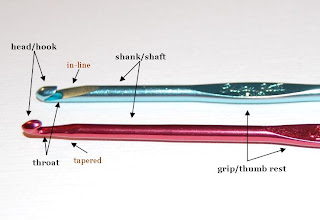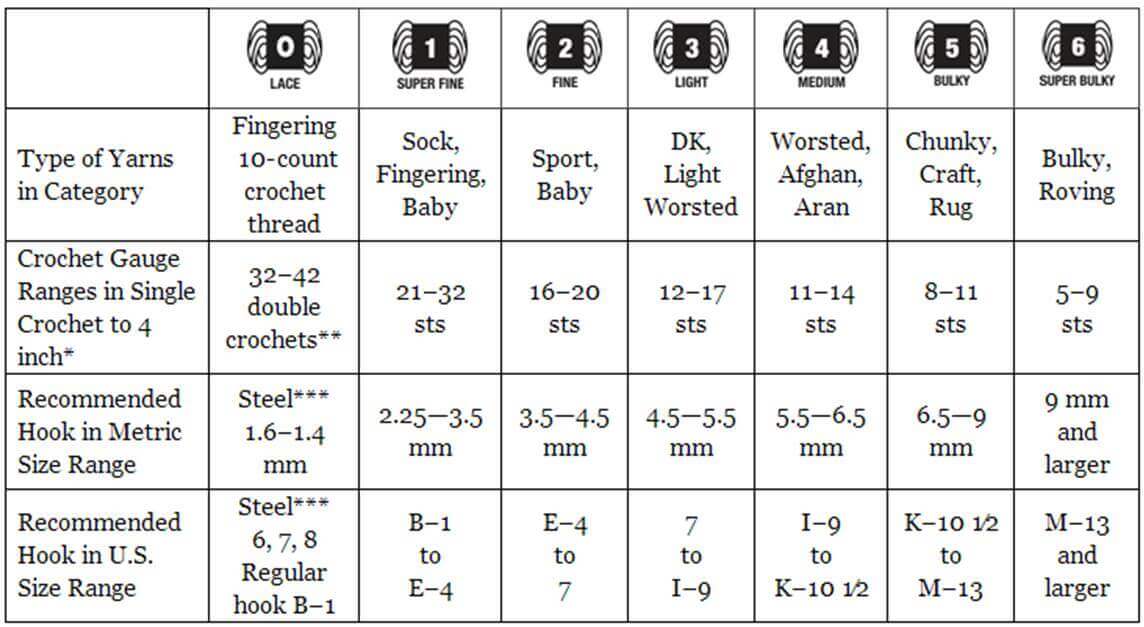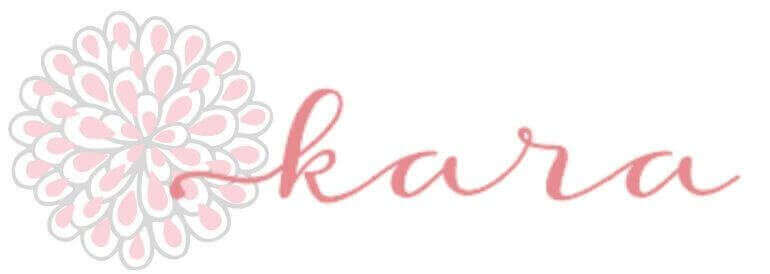WARNING – MAY INCITE ADDICTIVE BEHAVIOR!
I am so excited that you want to learn to crochet!! But I warn you now … it is addictive. I love everything about crocheting … the different hooks, the feel of the yarn, and the challenge of a new project. It is the perfect hobby because you don’t need much to get started, mainly just a hook and some yarn, and it is so portable.
I hope you enjoy it as much as I do!Before we get into the stitches, let’s go over a few basics. Getting Hooked
Crochet hooks come in different styles, sizes, shapes, and materials. They can be made from plastic, metal, wood, bamboo, nylon, and even bone. Some have a smooth tapered throat, while others have a more in-line flat throat. There are hooks with ergonomic handles, and there are novelty hooks, such as those that glow in the dark. There are large hooks that accommodate thicker yarns and achieve a certain look and tiny hooks used for creating lace, and all different sizes in between. Fig. 1 shows an assortment of different styles of hooks.
All crochet hooks have the same basic parts: the head or hook, the throat, the shank or shaft, and the handle with the grip or thumb rest. See Fig. 2 for an illustration of these parts.
Fig. 1

Fig. 2
The size of the hooks can vary greatly and are referred to in metric sizes and in U.S. sizes. The table below shows the metric size and U.S. equivalent of standard crochet hooks. Please note that steel crochet hooks are generally used with lace weight yarns or crochet threads and are sized differently than regular hooks. The higher the number of the steel hook, the smaller the hook is. Steel hooks range in size from a #14 or .9 mm (the smallest) to a 00 or 2.7 mm (the largest).
- If sizing is important, such as for hats and other garments, use the hook size noted in your pattern or the hook size necessary to achieve the gauge (more on this in a later lesson).
- If sizing is not important, you can use the size recommended on your yarn label.
- Experiment with using different types of hooks and use the one that feels best to work with.
Metric (mm) | U.S. size |
2 | A |
2.25 | B-1 |
2.75 | C-2 |
3.25 | D-3 |
3.5 | E-4 |
3.75 | F-5 |
4 | G-6 |
4.5 | 7 |
5 | H-8 |
5.5 | I-9 |
6 | J-10 |
6.5 | K-10½ |
8 | L-11 |
9 | M/N-13 |
10 | N/P-15 |
15 | P/Q |
16 | Q |
19 | S |
Source: Craft Yarn Council’s www.YarnStandards.com
Fig. 3
Plant fibers are made from sources such as cotton, linen, hemp, soy, bamboo, and jute. This yarn is great for summer garments because it is lightweight, absorbs moisture, is very breathable, and keeps you cool in the heat.Yarn comes packaged in skeins, balls, or hanks (pictured in order from left to right in Fig. 3) and can be made from plant fibers, animal fibers, synthetic fibers, or blends.
Animal fibers are made from sources such as wool, mohair, cashmere, silk, angora, alpaca, and llama. This yarn is perfect for winter items because of its warmth. It is also very breathable and has a great ability for keeping its shape. Items made from animal fibers usually need to be washed by hand, however, some yarns, called “superwash” are chemically treated to prevent felting or fulling when washed.
Synthetic fibers are made from sources such as acrylic, viscose, nylon, rayon, and polyester. This yarn is usually less expensive, but they do not usually breath as well as animal and plant fibers. They are, however, usually very durable.
Make sure to check the label on the yarn before purchasing. The label contains such information as yardage, dye lot, suggested hook size, gauge, yarn weight, and care symbols (for more on care instructions and symbols, see my article Caring for Your Knitted or Crocheted Items).
Yarn weights range from lace, such as what is used for lacy, openwork designs, to super bulky yarns used in sweaters, scarves, and afghans (see yarn weight chart below; source: Craft Yarn Council’s www.YarnStandards.com).

* This chart is a guideline only and reflects the most commonly used gauges and hook sizes for specific yarn categories.
** Lace weight yarns are usually crocheted on larger hooks to create lacy, openwork patterns. Accordingly, a gauge range is difficult to determine. Always follow the gauge stated in your pattern.
*** Steel crochet hooks are sized differently from regular hooks — the higher the number, the smaller the hook, which is the reverse of regular hook sizing.
Source: Craft Yarn Council’s www.YarnStandards.com
How do I know which yarn to buy?
- Be sure to pick the weight of yarn noted in your pattern.
- Feel the different yarn in that weight range. Pick the one that feels the best to you and that you think you will enjoy working with.
- Check the laundering instructions on the yarn and make sure it is appropriate for the item you are making (i.e., do you want to be able to machine wash it?) .
- tape measure
- stitch markers
- tapestry needle
- scissors
- paper and pen
Are you all ready to continue? See Lesson 2 — Getting Started.


My young neighbor, in being the recipient of my crocheted baby gifts, has asked me to teach her how to crochet too. This “Learn to Crochet, Lesson 1” is a perfect reference in showing her the fun and relaxing world of crochet. Thank you for publishing these “Learn to Crochet” lessons. They’re perfect for teaching the art of crochet.
thanks for the knowledge about crocheting. really useful as i am a beginner. 😉
Thanks for a great starter. What brand of hooks do you use?
I appreciate learning the starting of crocheting–i’m very excited and can’t wait for lesson 2–THANK YOU
thanks for linking up to totally tutorials tuesday. You were featured today!!
Have an awesome weekend!!
this is fantastic a few of my friends and I are are barely getting into crocheting thanks! I would love you to add this and any other posts you want to show off to my What We Wore and Made party over at http://raegunwear.blogspot.com/search/label/WWWMW
I love this! I’m a crocheter too and you explained everything so well. Thanks for sharing at Taking A Timeout Thursday!
This is good stuff you are sharing.. I am a very basic at crochet, my mom thought me the chain stitch and a few hooking looking through the book.. I am so interested in your new posts about crochet..
Thanks for linking up
Love
Hani
Thanks so much for linking up this weekend @ CountryMommaCooks Link & Greet party..Great post I’ll be back because i’ve always wanted to learn how to crochet…Have a wonderful week!
I haven’t done any crocheting in years, but would love to pick it up again. I’ll have to follow your lessons! Thanks for the great info!
Great post! I read every bit of it. I love to crochet.
Okay can you tell me who make the top hook in the first picture please it would be perfect for my ma.
[email protected]
Thanks I will have to give one a try too.—Robin
That hook is an Addi swing hook. She would love it!
What a fabulous tutorial. I have always wanted to learn how to crochet. This is a great starter tutorial. Thank you for linking to Totally Tutorial Tuesdays. 🙂
Well, I am just going to have to start payng attention. I crochet free-form all the time, but I really want to learn to follow patterns. I assume you’ll get down to that at some point. I’m excited!
Free-form is so much fun!! I am hoping to get to some tutorials on following patterns in the future 🙂 Thanks for stopping by my site!
I crochet or knit daily. It is quite addicting!
I know. I love it! Thanks for stopping by my site 🙂
Yes, VERY nice and helpful intro! I haven’t crocheted for a long time. Maybe it’s time to get back into it. I do have a Viking hat pattern for a toddler that is for crochet and that might be just the incentive I need. It’s SO CUTE!
That sounds cute!! You should definitely try it out. I bet you will pick up right where you left off 🙂
Well, since I am totally adicted to scarves, maybe I should learn how to crochet! Great intro!
Thanks, Sharon!